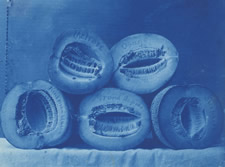
THE EXHIBITIONIntroduction Biography Botany Horticulture NY State College of Agriculture Cornell University Nature Study Education of Women Commission on Country Life Hortorium Writings Travel |
 |
PHOTOGRAPHYCyanotypes Bailey’s favorite method of printing glass plate negatives was to make cyanotype prints. While he sent his negatives to a professional photographer to develop, he usually made his own prints. Cyanotypes require only the use of natural sunlight for exposures and plain water for development. This simple procedure appealed to photographers like Bailey, who produced many thousands of negatives. Indeed, it became the most popular print process for amateurs between about 1880 and 1910, when Bailey was most active photographically. Bailey also discovered that cyanotypes were easy to collect and paste into albums.
|
||
 |
This exhibition is made possible through a generous gift in memory of Lelah A. Cole.
© 2004 Division of Rare & Manuscript Collections. If you have a question or comment, please contact us. | Web Accessibility Assistance |